Dinghy Cover
15/08/08 21:05
My Suzumar dinghy is over 6 years old. There are two problems with inflatable dinghies in the tropics. They become too hot to sit on and prolonged exposure to sunlight causes the fabric to deteriorate and become very sticky. Locals use a product called Super Pasta Fortlimp to clean up the latter.
Yvan and Cristina made me a cover which will solve both problems.

It fits over the tubes and fittings and is secured with lashings.

They included extensive chafe protection.

Yvan and Cristina made me a cover which will solve both problems.

It fits over the tubes and fittings and is secured with lashings.

They included extensive chafe protection.

Leak Control
14/08/08 22:45
Leak control above my bunk was only partially successful. Flow was reduced but not stopped. Close examination revealed another hole outboard from the others and in the locker. Rather than just bunging in some sealant I enlarge the hole and seal it with epoxy filler.

Two more holes in the forepeak.

Port pulpit bolt also leaking.

I'm gradually checking the contents of all lockers. It is amazing the number of stainless steel items from quality manufacturers that rust. My Orbis tweezers and Gerber multitool have succumbed.



Two more holes in the forepeak.

Port pulpit bolt also leaking.

I'm gradually checking the contents of all lockers. It is amazing the number of stainless steel items from quality manufacturers that rust. My Orbis tweezers and Gerber multitool have succumbed.


Another Cockroach
12/08/08 21:34
More maintenance. Today I emptied the forepeak for cleaning and leak tracking.
In the bottom of the forepeak was roach #2. Thankfully very dead in a little puddle of saltwater. I presume that at some point he came on board with fruit or vegetables which are normally stored in the forepeak.
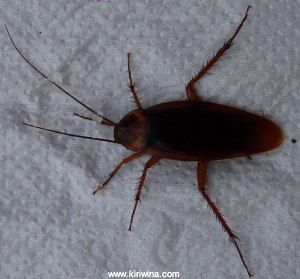
It looks as though deckhead leaks are going to be a problem as the teak deck ages. I decided to check as many areas as I could reach. This headlining above the heads clothing locker is very neat but difficult to remove given minimal clearance. There were no leaks but opposite on the starboard side was another leak.
With hindsight teak decking is not a good idea. It looks and feels lovely but during installation a perfectly watertight deck is turned into a sieve as many holes are drilled to secure the decking. These holes are not sealed and the decking screws self tap into GRP. Another problem with teak is that in the tropics it becomes too hot to walk on.
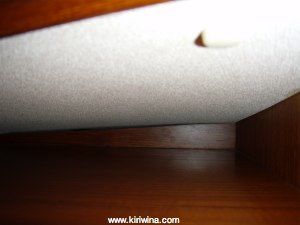
Chain locker. The windlass motor is just visible at the top.
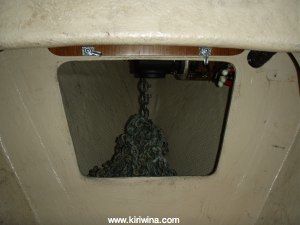
Another teak deck hole. Not visible here but the results clearly are. The hole is right above the motor and ipossible to reach without removing the entire windlass. Salt water has dripped onto the motor causing extensive corrosion.
My solution was to attempt to force some filler into the hole, clean and grease the motor and install a plastic cover (half a large water bottle) to divert water from the motor.
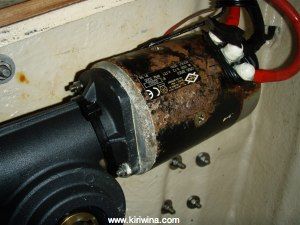
Forepeak showing windlass wiring and a leaking pulpit securing bolt.
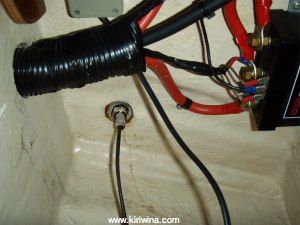
Pulpit securing bolt with starboard side light wire. The pulpit was repaired and reinstalled by Northshore prior to delivery in August 2005. It leaked in two ways, through the hole in the deck and through the hollow bolt.
It is difficult to seal as the GRP surface is not flush and the pulpit pads are very small. I resealed it again in Gijon in October 2006 but it still leaked. A proper solution would involve sitting the pulpit on teak deck pads and trying to create a flush surface on the deckhead. Meantime I sealed it again
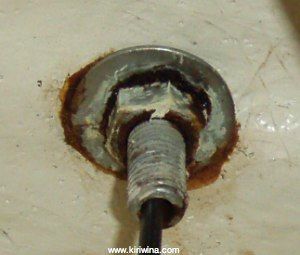
In the bottom of the forepeak was roach #2. Thankfully very dead in a little puddle of saltwater. I presume that at some point he came on board with fruit or vegetables which are normally stored in the forepeak.

It looks as though deckhead leaks are going to be a problem as the teak deck ages. I decided to check as many areas as I could reach. This headlining above the heads clothing locker is very neat but difficult to remove given minimal clearance. There were no leaks but opposite on the starboard side was another leak.
With hindsight teak decking is not a good idea. It looks and feels lovely but during installation a perfectly watertight deck is turned into a sieve as many holes are drilled to secure the decking. These holes are not sealed and the decking screws self tap into GRP. Another problem with teak is that in the tropics it becomes too hot to walk on.

Chain locker. The windlass motor is just visible at the top.

Another teak deck hole. Not visible here but the results clearly are. The hole is right above the motor and ipossible to reach without removing the entire windlass. Salt water has dripped onto the motor causing extensive corrosion.
My solution was to attempt to force some filler into the hole, clean and grease the motor and install a plastic cover (half a large water bottle) to divert water from the motor.

Forepeak showing windlass wiring and a leaking pulpit securing bolt.

Pulpit securing bolt with starboard side light wire. The pulpit was repaired and reinstalled by Northshore prior to delivery in August 2005. It leaked in two ways, through the hole in the deck and through the hollow bolt.
It is difficult to seal as the GRP surface is not flush and the pulpit pads are very small. I resealed it again in Gijon in October 2006 but it still leaked. A proper solution would involve sitting the pulpit on teak deck pads and trying to create a flush surface on the deckhead. Meantime I sealed it again

Awning
09/08/08 21:39
I went to see Ivan and Cristina to check on the progress of my order. They were watching the Olympics opening ceremony from Bejing. It was about 10:30 Brazilian time. I stayed to watch.
The Brazilian director keep crossing to various members of the Brazilian team to chat on mobile phones. He also had a foot fetish and kept zooming in on athletes feet.
After the ceremony finished I collected my new forward awning and the modified aft one.
This new awning will keep the fore cabin cool and allow the cabin hatch to be left open without the risk of a soaking.



More maintenance. On the atlantic crossing I repeatedly had water dripping on my head while I was in my bunk. During a rainstorm the other day I finally traced this leak to a hole that had been drilled in the deckhead when the teak decking was originally installed.
A lot of these holes were drilled and never sealed. Now after 10 years they leak. Repair involves removing the headlining, drilling out and cleaning the hole then sealing it with epoxy.
Another two holes sealed and hopefully no more water drops on my head.

The fordeck spotlight (new Sept 06) came with a long life sealed bulb which only lasted about 14 months. I found a replacement in Salvador and installed it today.
The Brazilian director keep crossing to various members of the Brazilian team to chat on mobile phones. He also had a foot fetish and kept zooming in on athletes feet.
After the ceremony finished I collected my new forward awning and the modified aft one.
This new awning will keep the fore cabin cool and allow the cabin hatch to be left open without the risk of a soaking.



More maintenance. On the atlantic crossing I repeatedly had water dripping on my head while I was in my bunk. During a rainstorm the other day I finally traced this leak to a hole that had been drilled in the deckhead when the teak decking was originally installed.
A lot of these holes were drilled and never sealed. Now after 10 years they leak. Repair involves removing the headlining, drilling out and cleaning the hole then sealing it with epoxy.
Another two holes sealed and hopefully no more water drops on my head.

The fordeck spotlight (new Sept 06) came with a long life sealed bulb which only lasted about 14 months. I found a replacement in Salvador and installed it today.
Café Gourmet Piata
04/08/08 22:40
While having lunch today we were invited to sample some coffee produced by a cooperative at Piata, some way inland from Salvador. In fact, Piata is so small that neither we nor the tourist office could find it on a map.
The coffee was lovely. The rep, who was visiting restaurants with his wife and daughter, gave us some samples and came aboard Günther’s boaat Cora-Mae for a vist. We were invited to drop by for a tour if we ever made it to Piata.
He gave us a ride into town in his pickup.


The coffee was lovely. The rep, who was visiting restaurants with his wife and daughter, gave us some samples and came aboard Günther’s boaat Cora-Mae for a vist. We were invited to drop by for a tour if we ever made it to Piata.
He gave us a ride into town in his pickup.


Lewmar Main Sheet Track
03/08/08 21:27
It was a very low tide this morning and the sandbank was exposed a lot more than usual. I dinghied over for a walk around.
Closer to the water it was more a sand/mud mix and fairly soft.

Looking back across the sandbank towards the marina around a mile away.
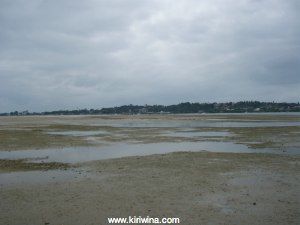
A dormant Petrobras drilling site. There are quite a few of these scattered around the bay.

Sea urchins cover themselves with shells when the tide is out.

Back on board I set about rigging the main sheet car. This Lewmar product was fitted new in July 2006 and has been washed regularly in fresh water since.
Some sheaves were a bit sticky and when I pulled it apart there was very heavy galvanic corrosion. One screw broke. This is pathetic and is caused by placing aluminium next to stainless steel without some form of insulation.

This mess, on a product sold for ocean use, only became visible after dismantling. It can be prevented by proper insulation which Lewmar have neglected to include.

There is an after market product called Lanocote but it is not available here. It is a grease like paste which if applied between unlike metals insulates against galvanic corrosion. Lewmar could do with some.
I cleaned and reassembled the car using lots of grease. An e-mail to the original supplier produced no response so the next step is an e-mail to Lewmar.
Closer to the water it was more a sand/mud mix and fairly soft.

Looking back across the sandbank towards the marina around a mile away.

A dormant Petrobras drilling site. There are quite a few of these scattered around the bay.

Sea urchins cover themselves with shells when the tide is out.

Back on board I set about rigging the main sheet car. This Lewmar product was fitted new in July 2006 and has been washed regularly in fresh water since.
Some sheaves were a bit sticky and when I pulled it apart there was very heavy galvanic corrosion. One screw broke. This is pathetic and is caused by placing aluminium next to stainless steel without some form of insulation.

This mess, on a product sold for ocean use, only became visible after dismantling. It can be prevented by proper insulation which Lewmar have neglected to include.

There is an after market product called Lanocote but it is not available here. It is a grease like paste which if applied between unlike metals insulates against galvanic corrosion. Lewmar could do with some.
I cleaned and reassembled the car using lots of grease. An e-mail to the original supplier produced no response so the next step is an e-mail to Lewmar.
Mast Track Gate
01/08/08 22:01
One definition of cruising is doing boat maintenance in exotic places.
The mast track gate on Kiriwina is a primitive arrangement.

The gate is held in place by one screw which, unless the track is blocked by a piece of cloth, invariably falls down the track to the bottom of the mast when the gate is removed. A place from which it is very difficult to retrieve the screw.
This arrangement has clearly caused problems in the past. There are now 5 securing holes of which 3 are stripped.
Over several hours I managed to recover 9 screws using a long piece of wire.
Gate in place with the top mainsail car in position ready to hoist.

The mast track gate on Kiriwina is a primitive arrangement.

The gate is held in place by one screw which, unless the track is blocked by a piece of cloth, invariably falls down the track to the bottom of the mast when the gate is removed. A place from which it is very difficult to retrieve the screw.
This arrangement has clearly caused problems in the past. There are now 5 securing holes of which 3 are stripped.
Over several hours I managed to recover 9 screws using a long piece of wire.
Gate in place with the top mainsail car in position ready to hoist.

